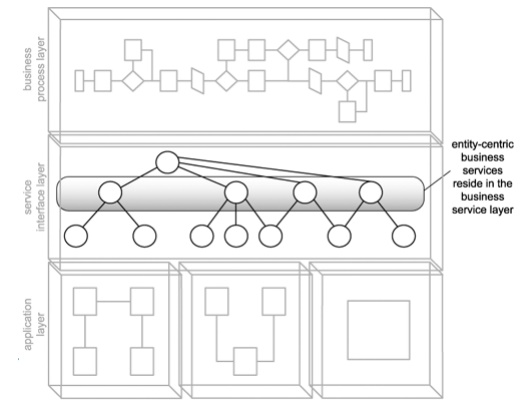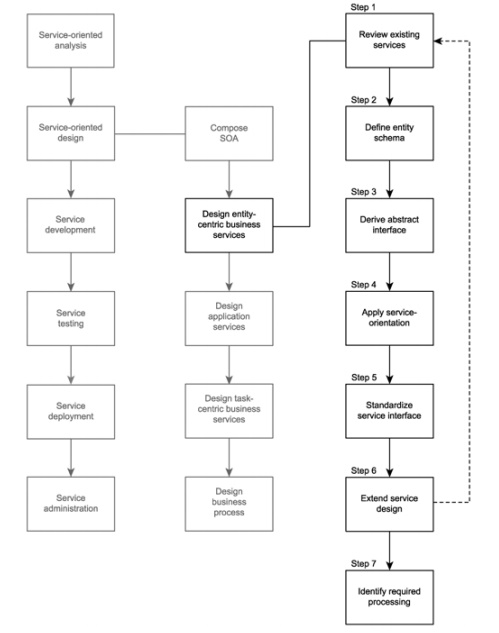Chapter: Service Oriented Architecture
Service Orinted Analysis
SERVICE ORINTED
ANALYSIS
PRE-REQUISITE DISCUSSION
Service-oriented analysis establishes a formal analysis process
completed jointly by business analysts and technology architects. Service
modeling, a sub-process of service-oriented analysis, produces conceptual
service definitions called imodeling processes result in the gradual creation
of a service inventory blueprint.
DERIVING BUSINESS SERVICES
With the detailed example explain about the entity- centric
business layer. Case Study This is only TLS's second service-oriented solution.
The first was created to establish an external interface with
their accounting system via a B2B environment.
That solution was built according to the top-down delivery
strategy and therefore resulted in a collection of entity-centric business
services.
Architects involved with the service design for this new
Timesheet Submission application are pretty confident that the new set of
services in no way overlaps with the existing ones.
However, because the B2B solution was built by a completely
different project team, they agree that it is worth the effort to review
existing services before commencing with the design process.
Their investigation reveals that the following entity-centric
business services were delivered as part of the B2B project: Accounts Payable
Service, Purchase Order Service, Ledger Service, and Vendor Profile Service
STEP 1..
The Employee Service candidate. Step2.
The existing inventory of TLS services. project architects then
conclude that no overlap exists, which gives them the green light to proceed
with the design of the Employee Service. TLS invested in creating a
standardized XML data representation architecture (for their accounting
environment only) some time ago. As a result, an inventory of entity-centric
XSD schemas representing accounting-related information sets already exists.
At first, this appears to make this step rather simple. However,
upon closer study, it is discovered that the existing XSD schema is very large
and complex. After some discussion, TLS architects decidefor better or for
worsethat they will not use the existing schema with this service at this
point.
Instead, they opt to derive a lightweight (but still fully
compliant) version of the schema to accommodate the simple processing
requirements of the Employee Service.
They begin by identifying the kinds of data that will need to be
exchanged to fulfill the processing requirements of the "Get weekly hours
limit" operation candidate. They end up defining two complex types: one
containing the search criteria required for the request message received by the
Employee Service and another containing the query results returned by the
service.
The types are deliberately named so that they are associated
with the respective messages. These two types then constitute the new Employee.xsd
schema file.
<xsd:schema
xmlns:xsd="http://www.w3.org/2001/XMLSchema"
targetNamespace= "http://www.xmltc.com/tls/employee/schema/accounting/">
<xsd:element name="EmployeeHoursRequestType"> <xsd:complexType>
<xsd:sequence> <xsd:element
name="ID" type="xsd:integer"/> </xsd:sequence>
</xsd:complexType> </xsd:element> <xsd:element
name="EmployeeHoursResponseType">
<xsd:complexType> <xsd:sequence> <xsd:element name="ID"
type="xsd:integer"/> <xsd:element name="WeeklyHoursLimit"
type="xsd:short"/> </xsd:sequence> </xsd:complexType> </xsd:element>
</xsd:schema>
Example 15.2. The EmployeeHistory schema, with a different
targetNamespace to identify its distinct origin. <xsd:schema
xmlns:xsd="http://www.w3.org/2001/XMLSchema"
targetNamespace= "http://www.xmltc.com/tls/employee/schema/hr/"> <xsd:element
name="EmployeeUpdateHistoryRequestType"> <xsd:complexType> <xsd:sequence>
<xsd:element name="ID"
type="xsd:integer"/> <xsd:element
name="Comment"
type="xsd:string"/> </xsd:sequence> </xsd:complexType> </xsd:element>
<xsd:element
name="EmployeeUpdateHistoryResponseType"> <xsd:complexType>
<xsd:sequence> <xsd:element
name="ResponseCode" type="xsd:byte"/>
</xsd:sequence> </xsd:complexType> </xsd:element> </xsd:schema>
To promote reusability and to allow for each schema file to be
maintained separately from the WSDL, the XSD schema import statement is used to
pull the contents of both schemas into the Employee Service WSDL types
construct.
The WSDL types construct being populated by imported schemas.
<types> <xsd:schema
targetNamespace= "http://www.xmltc.com/tls/employee/schema/"> <xsd:import
namespace= "http://www.xmltc.com/tls/employee/schema/accounting/"
schemaLocation="Employee.xsd"/> <xsd:import namespace=
"http://www.xmltc.com/tls/employee/schema/hr/"
schemaLocation="EmployeeHistory.xsd"/> </xsd:schema>
</types>
The TLS architects decide on the following operations names:
GetEmployeeWeeklyHoursLimit and UpdateEmployeeHistory
They subsequently proceed to define the remaining parts of the
abstract definition, namely the message, and portType constructs.
Example 15.4. The message and portType parts of the Employee
Service definition that implement the abstract definition details of the two
service operations. <message name="getEmployeeWeeklyHoursRequestMessage">
<part name="RequestParameter"
element="act:EmployeeHoursRequestType"
WSDL BASICS
CONTENTS:
WSDL stands for Web Services Description Language.
WSDL is a language for describing web services and how to access
them.
WSDL is written in XML.
WSDL stands for Web Services Description Language
WSDL is written in XML
WSDL is an XML document
WSDL is used to describe Web services
WSDL is also used to locate Web services
WSDL is a W3C recommendation
WSDL stands for Web Services Description Language.
WSDL is a document written in XML. The document describes a Web
service. It specifies the location of the service and the operations (or
methods) the service exposes.
he WSDL Document Structure
A WSDL document describes a web service using these major
elements:
Element Description
<types> A container for data type definitions used by the web
service
<message> A typed definition of the data being communicated
<portType> A set of operations supported by one or more endpoints
<binding> A protocol and data format specification for a particular
port type
The main structure of a WSDL document looks like this:
<definitions>
<types>
data type definitions........
</types>
<message>
definition of the data being communicated....
</message>
<portType>
set of operations......
</portType>
<binding>
protocol and data format specification....
</binding>
</definitions>
SOAP BASICS:
A WSDL document can also contain other elements, like extension
elements, and a service element that makes it possible to group together the
definitions of several web services in one single WSDL document.
WSDL Ports
The <portType> element is the most important WSDL element.
It describes a web service, the operations that can be
performed, and the messages that are involved.
The <portType> element can be compared to a function
library (or a module, or a class) in a traditional programming language.
WSDL Messages
The <message> element defines the data elements of an
operation.
Each message can consist of one or more parts. The parts can be
compared to the parameters of a function call in a traditional programming
language.
WSDL Types
The <types> element defines the data types that are used
by the web service.
For maximum platform neutrality, WSDL uses XML Schema syntax to define
data types. WSDL Bindings
The <binding> element defines the data format and protocol
for each port type. WSDL Example
This is a simplified fraction of a
WSDL document: <message name="getTermRequest">
<part name="term"
type="xs:string"/> </message>
<message
name="getTermResponse"> <part name="value"
type="xs:string"/>
</message>
<portType
name="glossaryTerms"> <operation name="getTerm">
<input
message="getTermRequest"/> <output
message="getTermResponse"/> </operation>
</portType>
The TLS architect in charge of the Employee Service design
decides to make adjustments to the abstract service interface to apply current
design standards. Specifically, naming conventions are incorporated to
standardize operation names
The revised Employee Service operation names.
Example
The two operation constructs with new, standardized names.
<operation name="GetWeeklyHoursLimit">
<input
message="tns:getWeeklyHoursRequestMessage"/> <output
message="tns:getWeeklyHoursResponseMessage"/>
</operation>
<operation name="UpdateHistory">
<input
message="tns:updateHistoryRequestMessage"/> <output
message="tns:updateHistoryResponseMessage"/> </operation>
As explained in the Apply naming standards guideline, the use of
naming standards provides native support for intrinsic interoperability, a key
contemporary SOA characteristic.
If entirely new tasks are defined, then they can be incorporated
by new operations that follow the same design standards as the existing ones.
If new functional requirements are identified that relate to
existing operations, then a common method of extending these operations is to
add input and output values.
This allows an operation to receive and transmit a range of
message combinations. Care must be taken, though, to not overly complicate
operations for the sake of potential reusability.
It often is advisable to subject any new proposed functionality
to a separate analysis process. Also, while it is desirable and recommended to
produce entity-centric services that are completely self-sufficient at managing
data associated with the corresponding entity domain, there is a key practical
consideration that should be factored in.
SOA COMPOSITION GUIDELINES
Service composability is a design principle, applied within the
service-orientation design paradigm, which encourages the design of services
that can be reused in multiple solutions that are themselves made up of
composed services. The ability of the service to be recomposed is ideally
independent of the size and complexity of the service composition.
This principle is directly responsible for the agility promised
by SOA as it promotes composing new solutions by reusing existing services.
ENTITY-CENTRIC BUSINESS SERVICE
DESIGN (A STEP-BY-STEP PROCESS):
Entity-centric business services represent the one service layer
that is the least influenced by others. Its purpose is to accurately represent
corresponding data entities defined within an organization's business models.
These services are strictly solution- and business process-agnostic,
built for reuse by any application that needs to access or manage information
associated with a particular entity.

atomically in relation to other service layers, it is beneficial
to design entity-centric business services prior to others. This establishes an
abstract service layer around which process and underlying application logic
can be positioned.
APPLICATION SERVICE DESIGN –
TASKCENTRIC BUSINESS SERVICE DESIGN

project architects then conclude that no overlap exists, which
gives them the green light to proceed with the design of the
Employee Service. TLS invested in creating a standardized XML data representation
architecture (for their accounting environment only) some time ago. As a
result, an inventory of entity-centric XSD schemas representing
accounting-related information sets already exists. At first, this appears to
make this step rather simple. However, upon closer study, it is discovered that
the existing XSD schema is very large and complex. After some discussion, TLS
architects decidefor better or for worsethat they will not use the existing
schema with this service at this point. Instead, they opt to derive a
lightweight (but still fully compliant) version of the chema to accommodate the
simple processing requirements of the Employee Service. They begin by
identifying the kinds of data that will need to be exchanged to fulfill the
processing requirements of the "Get weekly hours limit" operation
candidate. They end up defining two complex types: one containing the search
criteria required for the request message received by the Employee Service and
another containing the query results returned by the service. The types are
deliberately named so that they are associated with the respective messages.
These two types then constitute the new Employee.xsd schema file.
SIGNIFICANCE
The SOA is important because without this no service can be
provided to the user easy and efficiently
APPLICATION AREA:
The service oriented architecture is used in all the web
oriented service application in internet.
Related Topics